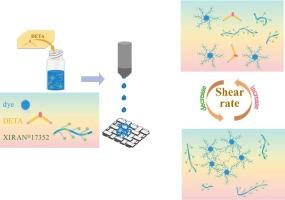Development of a thixotropic adjustable disperse dye ink for direct inkjet printing on polyester fabrics without pretreatment
IF 7.3
2区 材料科学
Q1 CHEMISTRY, APPLIED
引用次数: 0
Abstract
A novel thixotropic adjustable disperse dye ink has been successfully developed for direct inkjet printing on polyester fabrics without pretreatment by utilizing a thixotropic viscosity response mechanism without stimulus source. The origin of the non-stimulated thixotropy is the weak cross-linking of the amino group in diethylenetriamine (DETA) with the carboxyl group in polyanion XIRAN®17,352, which improves the printing effect. Tests on the physical and chemical properties, rheological properties and printability of the inks have demonstrated excellent overall printability. Low-field nuclear magnetic resonance (LF-NMR) shows that the addition of DETA enhances the physical cross-linking of the ink, which can effectively limit the mobility of water molecules in the ink system, thus reducing the spreading of the ink on the fabric surface. The ink spreading process shows that DETA enhances the viscoelasticity of the ink and prolongs the infiltration time of the ink droplets on polyester fabrics, thus alleviating the problem of ink bleeding on fabrics and forming a deeper value of print colour depth. Printed fabrics using Y-0.1-1.2 and B-0.06-1.2 inks have excellent colour acquisition, print clarity and colour fastness. Therefore, this adjustable thixotropic ink technology is expected to provide an economical and environmentally friendly alternative for environmentally friendly printing of polyester fabrics.

聚酯织物不经预处理直接喷墨印刷用触变可调分散染料油墨的研制
利用无刺激源的触变性黏度响应机制,成功研制出一种新型的可调分散染料直喷印花聚酯织物油墨。非刺激触变性的来源是二乙烯三胺(DETA)中的氨基与聚阴离子XIRAN®17,352中的羧基发生弱交联,从而改善了印刷效果。对油墨的物理和化学性能、流变性和印刷适性进行了测试,证明了优异的整体印刷适性。低场核磁共振(LF-NMR)表明,DETA的加入增强了油墨的物理交联,可以有效地限制油墨体系中水分子的流动性,从而减少油墨在织物表面的扩散。油墨的扩散过程表明,DETA增强了油墨的粘弹性,延长了墨滴在聚酯织物上的浸润时间,从而缓解了织物上的油墨出血问题,形成了更深的印刷品颜色深度值。使用Y-0.1-1.2和B-0.06-1.2油墨的印花织物具有优异的显色性、印花清晰度和色牢度。因此,这种可调触变油墨技术有望为涤纶织物的环保印花提供一种经济环保的替代方案。
本文章由计算机程序翻译,如有差异,请以英文原文为准。
求助全文
约1分钟内获得全文
求助全文
来源期刊

Progress in Organic Coatings
工程技术-材料科学:膜
CiteScore
11.40
自引率
15.20%
发文量
577
审稿时长
48 days
期刊介绍:
The aim of this international journal is to analyse and publicise the progress and current state of knowledge in the field of organic coatings and related materials. The Editors and the Editorial Board members will solicit both review and research papers from academic and industrial scientists who are actively engaged in research and development or, in the case of review papers, have extensive experience in the subject to be reviewed. Unsolicited manuscripts will be accepted if they meet the journal''s requirements. The journal publishes papers dealing with such subjects as:
• Chemical, physical and technological properties of organic coatings and related materials
• Problems and methods of preparation, manufacture and application of these materials
• Performance, testing and analysis.
 求助内容:
求助内容: 应助结果提醒方式:
应助结果提醒方式:


